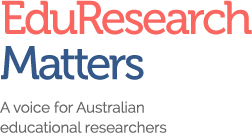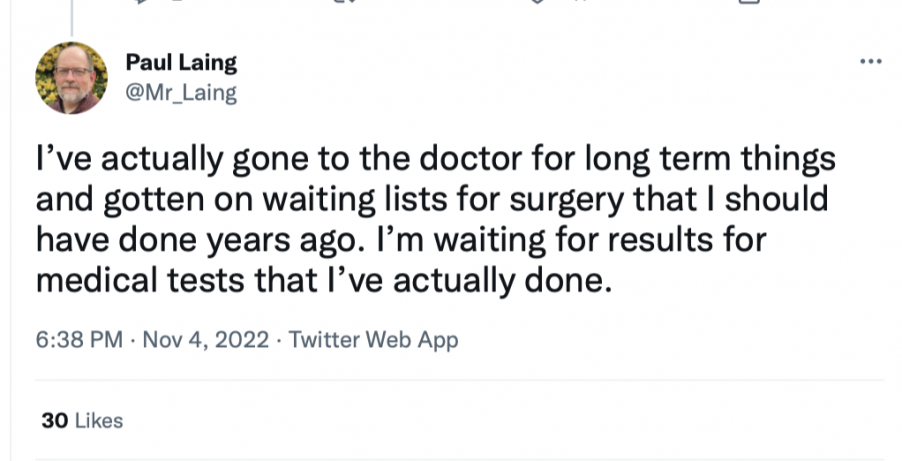One of our intermittent blogs during the #AARE2022 conference. If you want to cover a session at the conference, please email jenna@aare.edu.au to check in. Thanks!
This blog was put together by Naomi Barnes of QUT, Rafaan Daliri-Ngametua of ACU and Kathleen Smithers of Charles Sturt University.
Naomi Barnes writes:
The University of Aukland represented well in the Policy and Politics SIG on Day 1 of the AARE conference with one paper on reading for pleasure in the NZ curriculum and shadow education regulation in China.


Ruth Boysak (pictured, left) challenged the individualistic approach to reading education that has come from the UK to dominate NZ education. Reading for pleasure has recently been inserted into the NZ curriculum but there is very little research on the activity in a social context. The idea of enjoying a book alone is deeply embedded in reading education and dominates how the practice is thought about in school, reseach and policy contexts. However, reading is an intensely social practice and there is virtually no research into social reading in NZ. Boysak explained that some NZ children preference their family and community activities over reading because reading is framed as an individual activity. We need to engage in more research about the sociality of reading if reading for pleasure is a new staple in the curriculum.
Carlos Liuning (pictured right) reported on a student-led project investigating the regulation of shadow education in China. In China shadow education is supplementary to the schooling the Chinese government provides – approximately 10 million tutors support this industry. Before 2018, shadow education was largely unregulated in China. In recent years the Chinese government has made it impossible for these private tutoring companies to operate leading to the mass unemployment of these workers. Liuning and colleagues are conducting their research to show the Chinese government that tutors are teachers and that there is still room in the regulated system for both private tutors and government teachers.
Two fascinating papers.
Rafaan Daliri-Ngametua writes on the Time Poverty Problem
This morning I had the pleasure of attending the Teachers and Time Poverty presentation, in the Teachers’ Work and Lives SIG. A/Prof Nicole Mockler, Dr Anna Hogan, Dr Meghan Stacey, Dr Sue Creagh and Professor Greg Thompson (in absentia) introduced the Time Poverty Problem – it was a thrilling introduction to their ARC linkage project! Tackling the current, confronting and significant concerns around the intensification of teachers’ work, they presented a synthesis of existing, empirical research. More specifically, they explored how the concepts of workload and work intensification are being operationalised and how they may explain teachers and school leaders’ experiences of being time poor. Interestingly, they identified that ‘decision making’ practices and processes may be where the intensity of the work in schools manifests. Such ‘heavy hours’ (Beck, 2017) are in fact on an upward trend, with alarming negative impacts on job satisfaction and ultimately on the student experience. While the pressure to perform within the complex and multifaceted conditions of teachers’ work is not a new area of research, the work presented in this session introduced a seminal approach to tracking the granular details of how and where teachers are spending their time. While the project is hoping to capture the ebb and flow of the daily work of teachers, Anna rightfully pointed out that in fact there may be no ebb or flow but rather the intensity of the work of those in schools is seemingly sustained and unrelenting.
The irony of this project was not lost on the presenters as they candidly discussed the complexity of researching and conceptualising time poverty and time poor teachers by necessarily taking up teachers’ time. However, to address this complexity they have developed a Time Tracker App – a methodological stroke of genius that allows for teachers to efficiently input their activities through various snap shots throughout their day. The data points from the initial pilot have produced fascinating outcomes and quandaries with vast implications on how we understand time in the teaching workforce. This presentation was moving and thought provoking. The captivated audience was enthralled by the teams’ academic rigour and scholarship, the innovative research approach as well as the timely and critical nature of the research problem and the ongoing implications. The second pilot of the research is currently underway! We will wait with great anticipation for more updates and outcomes from this formidable team and from what will be one of the pivotal projects of our time.
Kathleen Smithers on philanthropy in Australian public schooling Symposium
Categories of philanthropy in Australian Public schooling from Anna Hogan and Alexandra Williamson
In this paper Hogan and Williamson map six categories of school funding to problematise the common argument that philanthropic funding in Australia is characterised by the “hyper agency of billionaires”. Indeed, they argue that it is both “easy and obvious to critique philanthropic funding”, but these philanthropic categories exist due to decreasing levels of school funding. They used desk research to identify the multiple forms of philanthropic funding, mapping these against the reforms set out by recommendation 41 of the gonski review. This paper sets the scene for the papers that follow, by identifying the landscape of Australian philanthropic funding. There are six categories identified: foundations, charities, intermediaries, not-for-profits, churches and Parent and Citizen associations. Hogan draws attention to the types of philanthropic funding that we may take for granted, such as Healthy Harold, and asks why we might question church funding of schools, but not other organisations.
Philanthropy, marketing disadvantage and the enterprising public school from Jess Gerrard, Elisa Di Gregorio and Anna Hogan
Following on from the previous papers mapping of philanthropy, they begun by identifying that Schools Plus is just one element of philanthropic funding in Australia. They argue that there are discourses which shape Australian schooling as “in crisis” and that this fuels the argument for philanthropic funding, which further fuels the idea of a “crisis” of funding in Australian schooling. Using interviews with people who work at Schools Plus and desktop review data, they unpack the conditions of possibility for philanthropic funding and the positioning of schools as entrepreneurs of their own futures. Interestingly, the administration of funding is mediated through a gate keeping process whereby schools must show some measures of ‘impact’ that can be provided to donors as evidence of their ‘legacy’.
The discussion that followed these papers explored the ways that Schools Plus administer funding and raised questions over who chooses funding? Who gets funded? And there were discussions about the missing links of fundings and the ways that schools are becoming entrepreneurs of gathering funding, with particular reference to P&Cs.

































